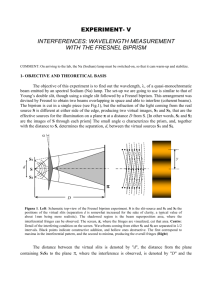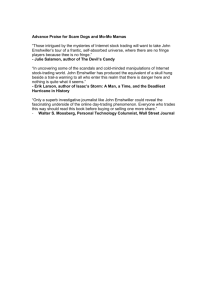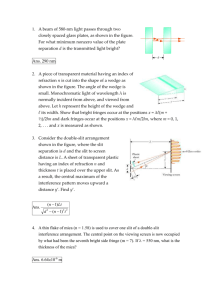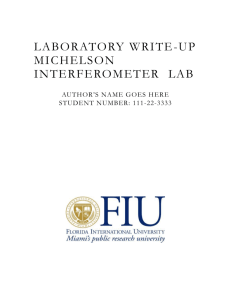Application of Fresnel Biprism
advertisement
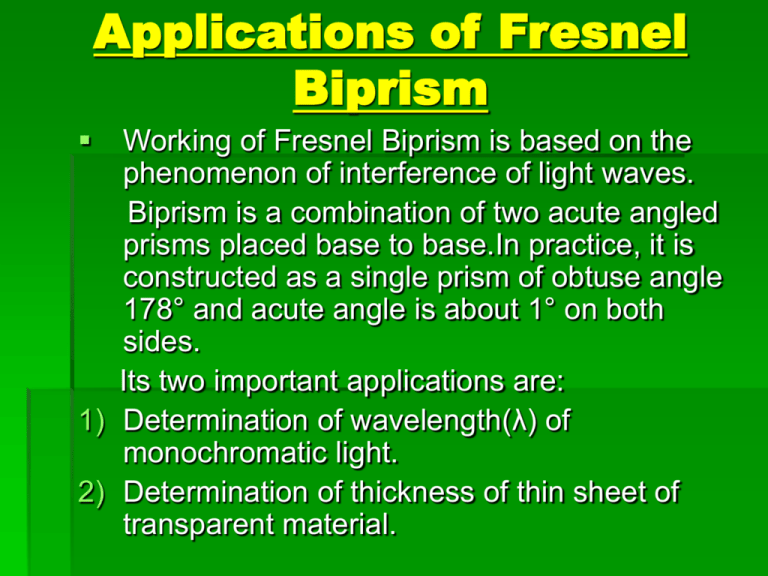
Applications of Fresnel Biprism Working of Fresnel Biprism is based on the phenomenon of interference of light waves. Biprism is a combination of two acute angled prisms placed base to base.In practice, it is constructed as a single prism of obtuse angle 178° and acute angle is about 1° on both sides. Its two important applications are: 1) Determination of wavelength(λ) of monochromatic light. 2) Determination of thickness of thin sheet of transparent material. D=distance between source of waves & screen. d = distance between virtual sources which are produced by refraction. When the light from source s falls on the lower part of biprism,it appears to come from virtual source s2 due to refraction. Similarly when light from the source s falls on the upper part of biprism ,it appears to come from the virtual source S1. Hence,S1andS2 act as two coherent sources. The point o on the screen is equidistant from source S1 & S2,hence it has maximum intensity.On both sides of O,alternate dark & bright fringes are produced. Condition for maxima : Intensity at any point on the screen is maximum if path difference ∆=nλ ;where n=0,1,2,3……. Condition for minima : Intensity at any point on the screen is minimum if path difference ∆=(2n+1)λ/2 ;where n=0,1,2,3…… Expression for fringe width : Fringe width is given as: ß=λD/d Lateral shift and its removal Lateral shift :Shifting of fringes relative to crosswire when the eyepiece is moved along the bench is known as lateral shift. Removal of lateral shift : Line joining the slit and edge of biprism is made parallel to the length of optical bench .For this, slit and biprism are adjusted along the breadth of bench so that on moving the eyepiece along the bench,no lateral shift of fringes is observed. In order to determine the wavelength(λ) of monochromatic light (from source S) the following observations are made:- 1.)The position of slit and eyepiece and distance D are noted. 2.) Set the crosswire of eyepiece on one particular fringe and note the reading. Move the eyepiece and count the number of fringes shifted. Take reading again .Find the difference between these two readings and calculate ß. A convex lens between biprism and eyepiece is introduced . The distance between images of S1 and S2 (d) is measured . From figure it is clear d1/d=v/u=n/m md1=nd……….(i) Move the lens towards eyepiece and set it to position L2.Measure the distance between the two images.From fig d2/d=v/u=m/n nd2=md…….(ii) Multiply eq (i) &(ii) and solving we get: D=√(d1d2) Putting values of D,ßand d we get λ=ßd/D 2.) Determination of thickness of thin sheet of transparent material A and B are two virtual coherent sources. O be equidistant from A and B on the screen. D-distance between source and screen. d-distance between virtual sources G-transparent glass sheet having thickness t. P is any point on screen Let c0 be the velocity of light in air and c be the velocity of light in the sheet From figure: BP/co=(AP-t)/co +t/c BP=(AP-t) + (co/c) t But co/c=μ BP-AP=μt-t=(μ-1)t If P is the point occupied by nth fringe then path difference BP-AP=nλ (μ-1)t=nλ where n is the number of fringes in distance x. To find the number of fringes in distance x, we use a source of white light .The fringes are coloured with the central fringe as white .The cross wire is set at the central white fringe and reading of micrometer is noted .Now ,the plate is introduced from one side such that a shift in central fringe is observed .The crosswire is moved with the help of micrometer screw and reading is again noted. The difference between the two readings gives the value of shift which is equal to x . The source of white light is now replaced by a monochromatic source of light and fringes are seen in the eyepiece .The number of fringes n are calculated by moving the micrometer through the same distance x and thickness of sheet ‘t’ is calculated.


